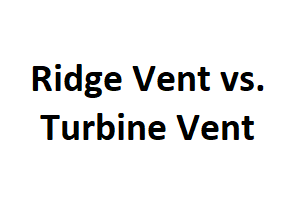When it comes to keeping our homes well-ventilated, the type of roof ventilation system we choose plays a crucial role. Ridge vents and turbine vents are two popular options that effectively exhaust hot and humid air from the attic, promoting a healthier and more energy-efficient living space. While both serve the same purpose, they operate differently and have distinct advantages. In this blog post, we will explore the differences between ridge vents and turbine vents to help you make an informed decision for your home.
Design and Functionality:
Ridge Vent: A ridge vent is a low-profile vent installed along the entire length of the roof’s ridge. It is designed to blend seamlessly with the roofline, making it less noticeable from the ground. Ridge vents consist of a narrow, continuous opening covered by a weather-resistant material. This design allows hot air to escape naturally as it rises to the peak of the roof, creating a natural stack effect. As the hot air escapes, fresh air is drawn in through the soffit vents, ensuring consistent airflow throughout the attic space.
Turbine Vent: On the other hand, a turbine vent (also known as a whirlybird or a roof vent turbine) features a more noticeable, turbine-like design. The vent has a series of vanes or blades that spin when wind passes over them, creating a vacuum effect that pulls air out of the attic. Turbine vents rely on wind power for ventilation, meaning they are particularly effective during windy conditions. However, their effectiveness can vary depending on the wind speed and direction.
2. Installation:
Ridge Vent: Installing a ridge vent typically involves cutting a continuous opening along the ridge of the roof and covering it with the vent material. This process requires precision and professional expertise to ensure a watertight seal. Ridge vents can be made of various materials, including metal, shingle-over, or plastic, depending on the manufacturer and the specific requirements of the roof.
Turbine Vent: Turbine vents are comparatively easier to install. They are mounted on the roof’s surface, and their spinning action does not rely on any electrical connections or power sources. However, proper positioning is crucial to maximize their efficiency and prevent potential leaks.
3. Performance:
Ridge Vent: Ridge vents provide a continuous and even airflow along the entire length of the roof ridge. They are particularly effective in hot and humid climates, as they allow hot air to escape efficiently. Ridge vents are also generally quieter compared to turbine vents since they do not have moving parts.
Turbine Vent: Turbine vents are dependent on wind speed and direction. They work best in areas with consistent and strong winds. In windy conditions, turbine vents can expel a significant amount of hot air from the attic. However, during calm periods, their performance may be limited. Additionally, the spinning motion of turbine vents can create some noise, which might be a consideration for noise-sensitive individuals.
4. Maintenance:
Ridge Vent: Ridge vents are relatively low-maintenance since they do not have any moving parts. They are less prone to mechanical failures and require minimal upkeep. Periodic inspections to ensure they remain free of debris are generally sufficient.
Turbine Vent: Turbine vents, with their moving parts, may require more regular maintenance. The spinning action can accumulate dirt, dust, or even ice in cold climates, which can hinder their performance. As a result, periodic cleaning and inspections are necessary to ensure proper functioning.
Conclusion:
In conclusion, when deciding between a ridge vent and a turbine vent for your home, it’s essential to consider various factors such as your roof design, local climate, and personal preferences. Ridge vents offer consistent and quiet ventilation, making them an excellent choice for many homes, though professional installation is required. On the other hand, turbine vents are easier to install and can be highly effective in windy regions. Their performance may vary during calm periods, and maintenance needs to be more frequent. To make the best decision, seek guidance from a roofing professional who can assess your specific needs and help you choose the ventilation system that will provide optimal airflow, improve energy efficiency, and maintain a comfortable living environment for years to come.
